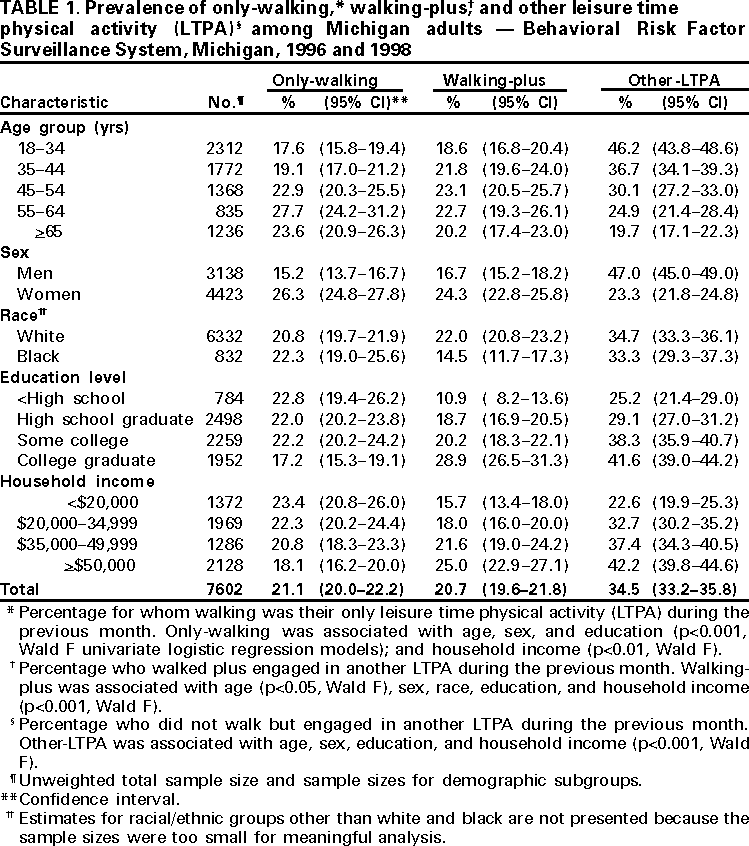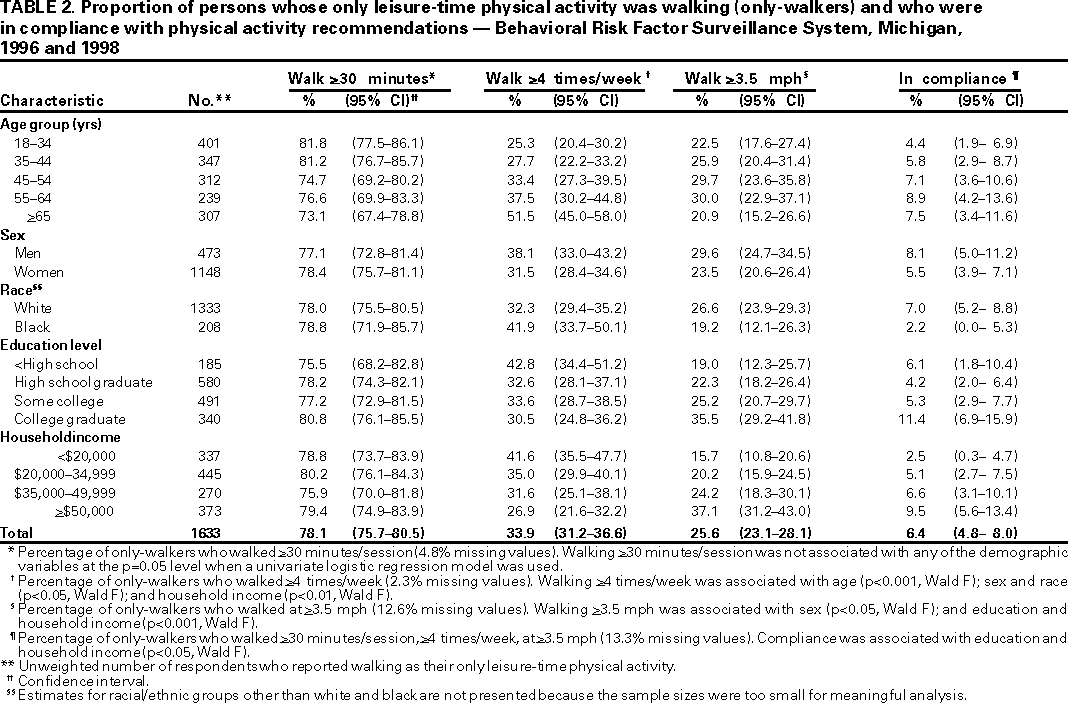 |
|
|
|
|
|
|
|
|
|
|
|
|
|
|
|
|
||||
| ||||||||||
|
|
|
|
Compliance With Physical Activity Recommendations by Walking for Exercise --- Michigan, 1996 and 1998Physical inactivity is an important modifiable risk factor for many diseases, including cardiovascular disease, cancer, diabetes, and osteoporosis. The 1996 Surgeon General's report (1) recommended that persons of all ages obtain "a minimum of 30 minutes of physical activity of moderate intensity (e.g., brisk walking) on most, if not all, days of the week." Walking is encouraged as one of the most accessible ways to be physically active (2), is the most commonly reported leisure- time physical activity (LTPA) in the United States, and is relatively common among groups that are typically inactive (e.g., the elderly and low-income groups) (3). To determine whether exercise characteristics (i.e., duration, frequency, and speed of walking) of Michigan adults met the Surgeon General's recommendations, the Michigan Department of Community Health analyzed data from the 1996 and 1998 Michigan Behavioral Risk Factor Surveillance System (BRFSS) for those who reported walking as their only LTPA. This report summarizes the results of this analysis, which indicate that most walkers need to increase the frequency and perhaps the speed of their walking to comply with recommendations. BRFSS is a random-digit--dialed telephone survey of the civilian, noninstitutionalized U.S. population aged >18 years that includes questions about LTPA. In 1996 and 1998, respondents were asked "During the past month, did you participate in any physical activities or exercises such as running, calisthenics, golf, gardening, or walking for exercise?" Information on the type, distance, frequency, and duration of respondents' two predominant LTPAs was collected. Data from the 1996 and 1998 Michigan BRFSS were combined for this analysis (n=7602). Walking speed was calculated by dividing the reported distance by duration. Brisk walking was defined as walking at >3.5 mph (4). Data were weighted, and descriptive analyses (prevalence and standard errors) and univariate logistic regressions were performed using SUDAAN (5). In this analysis, comparisons with p<0.05 were considered statistically significant. Estimates for racial/ethnic groups other than white and black are not presented because the sample sizes were too small for meaningful analysis. Overall, approximately 76% of Michigan adults engaged in LTPA. The prevalence of walking as their only LTPA (i.e., only-walking) was 21%, the prevalence of walking plus another LTPA (i.e., walking-plus) was 21%, and the prevalence of engaging in any other type of LTPA (i.e., other-LTPA) was 35% (Table 1). The prevalence of only-walking was associated significantly with age, sex, and education and income levels. The prevalence of only-walking significantly increased with age up to ages 55--64 years, was significantly higher among women than men, was similar between blacks and whites, but was lower among persons in the highest education and income categories. Most (78%) only-walkers usually walked at least 30 minutes at a time (Table 2). The proportion walking for at least 30 minutes was not related significantly to any demographic characteristic. Thirty-four percent of only-walkers walked four or more times per week; this proportion increased with increasing age, was higher among men and blacks, and showed an inverse relation with income. Twenty-six percent of only-walkers walked briskly; this proportion was significantly higher among men than women and increased with education and income levels. Six percent of only-walkers met the health-related recommendations (1) by walking at least 30 minutes per session, four or more times per week, at >3.5 mph (Table 2). This proportion was associated significantly with education and income and was higher among higher education and income groups. Reported by: AP Rafferty, MJ Reeves, HB McGee, Div of Epidemiology Svcs, Bur of Epidemiology, Michigan Dept of Community Health; JM Pivarnik, Dept of Kinesiology and Dept of Osteopathic Surgical Specialties, Michigan State Univ, East Lansing, Michigan. Physical Activity and Health Br, Div of Nutrition and Physical Activity, National Center for Chronic Disease Prevention and Health Promotion, CDC. Editorial Note:The findings from this study indicate that walking was the most common form of LTPA and that most only-walkers (78%) were walking for at least 30 minutes at a time. However, many only-walkers did not walk frequently enough or fast enough to comply with recommendations (1); 34% walked at least four times a week, and 26% walked briskly enough to achieve a moderate-intensity level. Race is not a risk factor for lack of LTPA but may be a marker for other factors that may be predictive of a higher prevalence of physical inactivity during leisure time. Findings from this study indicate that the prevalence of any LTPA during the previous month was somewhat lower among blacks (70.1%) than whites (77.5%). However, the prevalence of only-walking was similar among the two racial groups, supporting the accessability of walking for exercise across groups. Although walking at 3.5 mph (approximately 17 minutes per mile) is a moderate-intensity activity for most persons, other circumstances and physical conditions exist (e.g., being unconditioned, elderly, overweight, or having a disabling condition) that influence activity level. Some persons may have chosen to only walk because of their physical fitness level or ability, and in such cases, a slower pace might be considered a moderate or appropriate level. The Surgeon General's report recognizes a continuum of intensity and duration for physical activity and suggests that sedentary persons start with short durations of a moderate-intensity activity and gradually increasing the duration and/or intensity (1). Although a person's health may benefit from walking at lower intensities (e.g., 2.0--2.9 mph) (6), persons should increase intensity as the body adapts. The findings in this report are subject to at least four limitations. First, BRFSS data are self-reported and include measurement error, especially related to respondents' recall of time and distance walked, which may be difficult for some respondents to estimate. Second, these data do not include information on non-LTPAs; therefore, total activity and total walking may be underestimated. Third, information on only two LTPAs was available within BRFSS, which may result in an underestimate of the percentage of Michigan adults who walk plus engage in another LTPA. Finally, these data include errors related to noncoverage and nonresponse. This report also is limited by the method used to calculate the intensity of physical activity. Obtaining an estimate of intensity from BRFSS data required dividing the estimates of average distance walked by the estimated time. If respondents did not know the distance, they may have guessed or reported that they did not know. The amount of missing data concerning distance (13%) and the unknown proportion of respondents who guessed incorrectly may have affected the accuracy of these results. Since 1997, questions that measure relative intensity directly (7) have been used in national surveys, and most epidemiologic studies that have documented beneficial health effects of moderate-intensity activity (including brisk walking) used duration or self-identified intensity rather than calculated intensity estimates (6,8). The national health objectives for 2010 (9) propose that public health professionals use relative-intensity data to track moderate and vigorous activity. BRFSS will incorporate these direct measures of moderate and vigorous physical activity starting with the 2001 surveys. Despite methodologic concerns, these results suggest that most persons who walk for physical activity would benefit from walking more regularly and perhaps faster. Public health efforts should focus on increasing the frequency of walking because once a person reaches 30--45 minutes of walking on most days of the week, most of this activity probably will be at moderate intensity relative to individual fitness levels. Because walking is the only LTPA used by 20% of Michigan adults, a public health campaign encouraging them to walk more frequently could have important health effects. References
Table 1  Return to top. Table 2  Return to top. Disclaimer All MMWR HTML versions of articles are electronic conversions from ASCII text into HTML. This conversion may have resulted in character translation or format errors in the HTML version. Users should not rely on this HTML document, but are referred to the electronic PDF version and/or the original MMWR paper copy for the official text, figures, and tables. An original paper copy of this issue can be obtained from the Superintendent of Documents, U.S. Government Printing Office (GPO), Washington, DC 20402-9371; telephone: (202) 512-1800. Contact GPO for current prices. **Questions or messages regarding errors in formatting should be addressed to mmwrq@cdc.gov.Page converted: 6/29/2000 |
|||||||||
This page last reviewed 5/2/01
|